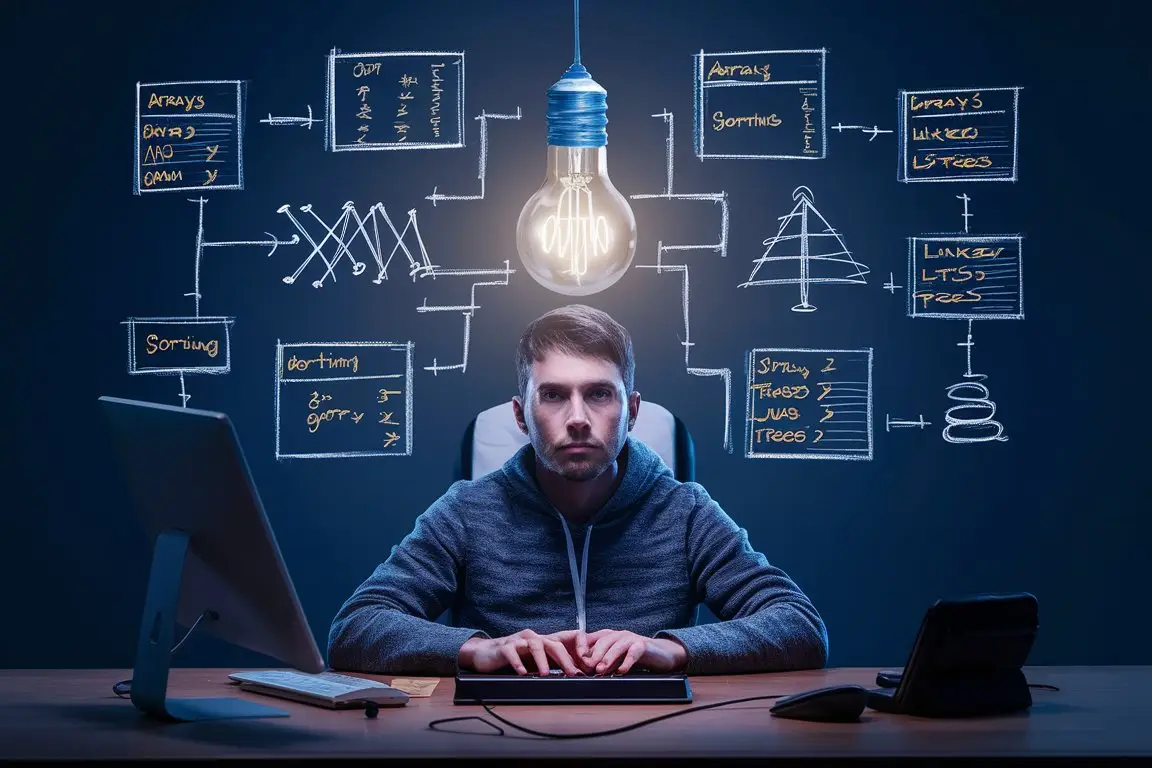Imagine a programmer facing a complex problem, sitting for hours on a computer struggling to find an efficient solution without a solid foundation in data structures and algorithms (DS&A). It is sometimes painful or very hard for programmers to comprehend the knowledge of DSA and Algorithms when they appear to them for the very first time. New frameworks, programming languages, and libraries, are emerging at an exponential pace. It can be a bit hard to get caught up in the latest trends and wonder if the foundational skills like mastering Data Structures and Algorithms still hold relevance. But The answer to that question is a resounding yes!
The world of technology is constantly evolving.
It’s just impossible to ignore DSA and get a computer science degree. Algo & DSA lies the very backbone of this field, even in today’s rapidly evolving tech landscape.
Table Of Contents
Why DS&A remains as the fundamental building blocks for programmers in 2024:
Universal Problem-Solving Tools:
Regardless of the specific technology or domain, programmers face problems that require efficient data organization and manipulation. DSA & A provided a universal toolkit that can be applied across various programming languages and platforms.
Understanding concepts like arrays, linked lists, trees, and graphs equips you to tackle these challenges effectively.
Now More Than Ever, Algorithmic Efficiency Is Important: The necessity for effective algorithms only grows as the volume of data we handle continues to grow or explode.
Learning algorithms enables you to build code that handles bigger datasets with greater scalability, quicker execution, and better memory management. Building high-performance apps in the data-driven world of today requires this.
A Foundation for Cutting-Edge Technologies:

While new technologies like machine learning and artificial intelligence seem complex, Behind the scenes, they mostly rely on complex algorithms and data structures. A strong understanding of DSA & A provides a solid foundation for exploring and understanding these emerging fields.
Technical Interview Powerhouse:
DSA & A remain a cornerstone of technical coding interviews. Companies just love to value candidates who can demonstrate their ability to think logically, analyze problems, and design efficient solutions. Having a solid grasp of DSA & A will give you a significant edge in the competitive job market.
But the real question is what are the essential skills to Master Data Structures and Algorithms?
In this blog, we will see how mastering DSA empowers programmers to tackle challenges more effectively, write cleaner code, and enhance their career prospects.
Why Algorithms and DSA matter:
Imagine a programmer facing a massive pile of unorganized data – like a messy room filled with random items.
Finding specific information or completing tasks would be a nightmare. This is where Data Structures (DS) come in.
DSA provide the underlying structure for organizing data efficiently. Think of them like filing cabinets, shelves, or specialized containers for your data. Here are some common examples:
- Arrays: Basic lists that store information in a single, contiguous memory block for quick access and retrieval in a predetermined sequence.
- Linked Lists: Nodes that provide flexibility for dynamic data insertion and deletion, together with data and references to the next node.
- Trees: Hierarchical structures with parent-child relationships, perfect for efficient searching and sorting of complex data sets.
- Graphs: Relationships between data points are represented by networks of linked nodes, which can be used to describe social networks or navigation systems.
By choosing the appropriate DS, programmers can organize data in a way that optimizes access, storage, and manipulation. This efficiency becomes crucial when dealing with large datasets.
Now, let’s bring order to the data manipulation process. Algorithms define the step-by-step procedures for solving problems, ensuring optimal solutions. They act like a set of instructions that tell the computer how to process the data stored in your chosen DS.
Here’s how algorithms work:

- Input: Data is fed into the algorithm.
- Processing: The algorithm performs a series of defined steps based on the chosen data structure and desired outcome.
- Output: The processed data is presented as a solution.
Algorithms can be designed for various purposes:
- Searching: Finding specific information within a data structure (e.g., searching for a name in a phone book).
- Sorting: Arranging data in a specific order (e.g., sorting a list of products by price).
- Pathfinding: Determining the most efficient route between two points (e.g., navigation apps).
The “optimal” solution refers to choosing the algorithm that delivers the desired outcome using the least amount of computational resources (time and memory). This efficiency is critical for building high-performance applications.
Real-World Applications of DS&A:
You might be surprised by how frequently DS&A appear in your daily tech interactions:
Search Engines:
Algorithms like “PageRank” (based on graphs) analyze links between webpages to rank search results.
Social Media Platforms:
Data structures like hash tables store and retrieve user profiles efficiently. Recommendation systems use algorithms to suggest content based on your past interactions.
Navigation Apps:
Graph data structures map road networks, and powerful algorithms find the shortest or fastest route to your destination.
Online Shopping:
Search filters and recommended products rely on data structures and algorithms to match your preferences.
In a nutshell, DS&A are the invisible yet vital forces behind many of the technologies we rely on daily. By understanding their roles, programmers can build efficient, scalable, and user-friendly applications.
Benefits of Mastering DS&A:

Problem-Solving Powers:
DS&A knowledge equips programmers to break down complex problems into smaller, manageable steps and choose the appropriate data structures and algorithms for efficient solutions. The logical ability of anyone who has mastered DS&A is so developed that they think before they act. Every action they take for complex problems. They first think. This is the key that make them different from many programmers.
Code Optimization:
Imagine building a house without understanding the properties of bricks and pillars. That’s what coding can be like without DS&A.
Knowing data structures provides the right “building blocks” for organizing information efficiently. Understanding algorithms equips you to choose the most easy and useful “construction methods” for manipulating that data. This translates to clean, well-structured code that executes faster. DO you know Why?
By preventing pointless loops and data searches, DS&A reduces processing power wastage. Furthermore, by understanding how data structures store information, you may select the solution that best suits your needs and spare important memory space. Gaining proficiency in DS&A enables you to write reliable, effective code that runs smoothly.
Interview Preparation:
As I mentioned earlier, companies just love to test the logical and critical thinking ability of a programmer, by asking about complex algorithms and Data structures. Mastering these concepts provides an edge and increases the chance of landing your dream job.
Career Advancement:
Strong DS&A skills are highly sought-after in the tech industry and can open doors to better opportunities and career growth in the future.
Your Path to Mastering DS&A: A Beginner’s Guide and Beyond

Ready to embark on your DS&A journey now? Here’s a roadmap to get you started:
For Beginners:
Learning Resources: There’s a wealth of online resources available! Here are a few popular options:
Online Courses: Platforms like Coursera, edX, and Udacity offer comprehensive courses on DS&A, often with interactive exercises.
Tutorials: Websites like GeeksforGeeks and HackerRank provide free tutorials with explanations, code examples, and visualizations.
Books: Classic texts like “Introduction to Algorithms” by Cormen et al. offer a structured approach, while visual guides like “Grokking Algorithms” by Aditya Bhargava are great for beginners.
Practice Makes Perfect: Don’t just read – actively practice what you learn!
YouTube: Videos of complete courses on DS&A like GeeksforGeeks, Abdul Bari, Jenny’s lectures CS/IT and freeCodeCamp.org provide the best free of cost complete learning with admirable explanations and visualizations.
Coding Challenges: Platforms like LeetCode and HackerRank offer a vast library of coding problems focused on different data structures and algorithms.
Personal Projects: Apply your knowledge by building small projects that utilize specific data structures (e.g., a to-do list app using arrays).
For Experienced Programmers:
Brush Up on Specific Topics: Target your learning based on areas you want to strengthen. Online resources mentioned above often have dedicated sections for specific data structures and algorithms.
Sharpen Your Skills:
Online Coding Communities: Platforms like Stack Overflow and LeetCode Discussions allow you to connect with other programmers, ask questions, and learn from their experiences.
Contribute to Open Source Projects: Working on real-world projects can provide valuable practical experience in applying DS&A concepts.
Remember, mastering DS&A is a continuous learning process. Be patient, practice consistently, and use the vast resources available online and within the programming community.
Conclusion
The road to mastering DS&A may seem daunting at first, but the rewards are substantial. Not only will you become a more confident and efficient programmer, but you’ll also unlock a world of opportunities in your career.
Here’s a glimpse into the future you can create:
Tackle complex problems with ease. Break down challenges into manageable steps and design optimal solutions.
Write cleaner, more efficient code. Impress colleagues and employers with your well-structured and lightning-fast code.
Land your dream job. Shine in technical interviews with your deep understanding of DS&A fundamentals.
Note – If you wonder what steps you should take to land your dream developer job in 2024. Consider reading this article.
Embrace the future of technology. Be prepared to explore advancements in AI, machine learning, and other cutting-edge fields that rely heavily on DS&A.




What a information of un-ambiguity and preserveness of valuable experience regarding unexpected
emotions.